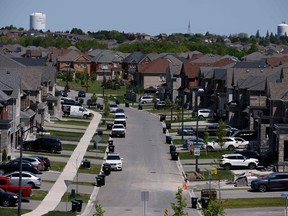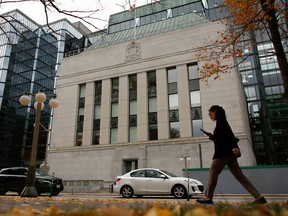Would be a ‘stretch’ to put too much blame on an undercount of NPRs
Article content
There are about a million more non-permanent residents in Canada than the official number that is widely quoted and used for planning purposes by various authorities, according to a recent report by CIBC World Markets Inc.
If ignored, the “undercounting” could hurt Canada’s housing and labour policies, said economist Benjamin Tal, who wrote the Aug. 30 report, Counting heads in Canada — a conundrum.
Advertisement 2
Article content
Article content
Statistics Canada keeps track of population counts in two ways. The first is the census, last published in 2021, which indicated there were about 925,000 non-permanent residents in Canada. It also provides quarterly and annual estimates of population growth. This estimate, Tal said, suggests the population of non-permanent residents in 2021 was about 1.17 million, or 250,000 more than what the census stated.
Statistics Canada said these estimates are based on post-census coverage studies of a representative sample of individuals to determine how many individuals were missed or counted more than once.
In addition, the CIBC report said that between 2017 and 2022, there were at least 750,000 non-permanent residents, which represent foreign workers, international students, holders of Minister’s Permits and refugees, who overstayed in Canada. Tal said Statistics Canada has yet to reflect these numbers.
Statistics Canada’s current system assumes that temporary resident visa holders have left the country 30 days after the expiry of their visa. The agency refers to this as an interruption period. However, Tal said there is a huge group of people who continue to stay in the country while applying for work visas, extension of resident visas and permanent visas.
Article content
Advertisement 3
Article content
While these residents are accounted for once their permit to stay is renewed, they are not counted — after the 30-day period — until their application is approved by government.
As such, to come up with the 750,000 number, Tal looked at the gap between the applications submitted to Canada and the number of approvals between 2017 and 2022. His report doesn’t indicate how many left the country during this period.
In total, he said Canada has undercounted the number of temporary residents by at least a million, and that since the country’s housing agency follows the census for its policies, the undercounting could worsen the existing housing crisis.
Demand is stronger than what official numbers are telling you and that’s why we are approaching zero vacancy rate in rental apartments
Benjamin Tal
“Demand is stronger than what official numbers are telling you and that’s why we are approaching zero vacancy rate in rental apartments,” Tal said. “We don’t have enough of them.”
He added that the undercounting could also have “major implications” on any government plan to put a cap on the number of international students.
Housing minister Sean Fraser on Aug. 22 said the government would need to do some “serious thinking” when it comes to the international student program, which has had immense growth in concentrated areas, as part of the government’s plans to ease existing housing pressures.
Advertisement 4
Article content
Statistics Canada defended its numbers. Spokesperson Melissa Gammage said the agency wasn’t aware of the data sources or the methodology used by CIBC to come up with the 750,000 figure.
“It’s true that the level of coverage of NPRs (non-permanent residents) in censuses can be more challenging than that of other groups,” she said in a statement. “However, after each census, StatCan conducts rigorous coverage studies to estimate the level of coverage of the census. The results are added to demographic estimates so that they consider NPRs missed by the census. This is the usual process of producing demographic estimates.”
Gammage also said that from Sept. 27 onwards, the agency will publish new data tables on non-permanent residents that will include interruption period rules, more details on NPRs, such as their estimated numbers and permit types, as well as other “improvements.” The new approach was previously planned and not in response to the CIBC report.
Tal welcomed the changes.
“We are blessed with one of the best statistical agencies in the world. We are heavy users of Stats Canada’s data,” he said. “The note was not aimed to criticize, but rather to point to some issues that need to be looked at.”
Advertisement 5
Article content
Bank of Nova Scotia analyst Rebekah Young said there should be an urgency in addressing data challenges with respect to population estimates, but added that it would be a “stretch” to put too much blame on an undercount for today’s strained infrastructure.
-

Ottawa needs to be careful with placing caps on international students
-

Poilievre says new immigrants warning people off Canada
-

Why immigration could be good for housing affordability
“Few, if any, jurisdictions have effectively planned for well-channeled immigration targets, let alone non-permanent categories,” she said. “Undocumented NPRs also would not have access to basic services like health and education so are unlikely pressure points in these systems. They would also not be purchasing homes.”
Young said there is an opportunity cost in economic terms since NPRs are not able to formally participate in the labour market and these numbers are looking “increasingly large.”
• Email: nkarim@postmedia.com
Article content
Missing million people not reason for strained housing, infrastructure
2023-08-31 16:26:18






Comments
Postmedia is committed to maintaining a lively but civil forum for discussion and encourage all readers to share their views on our articles. Comments may take up to an hour for moderation before appearing on the site. We ask you to keep your comments relevant and respectful. We have enabled email notifications—you will now receive an email if you receive a reply to your comment, there is an update to a comment thread you follow or if a user you follow comments. Visit our Community Guidelines for more information and details on how to adjust your email settings.
Join the Conversation